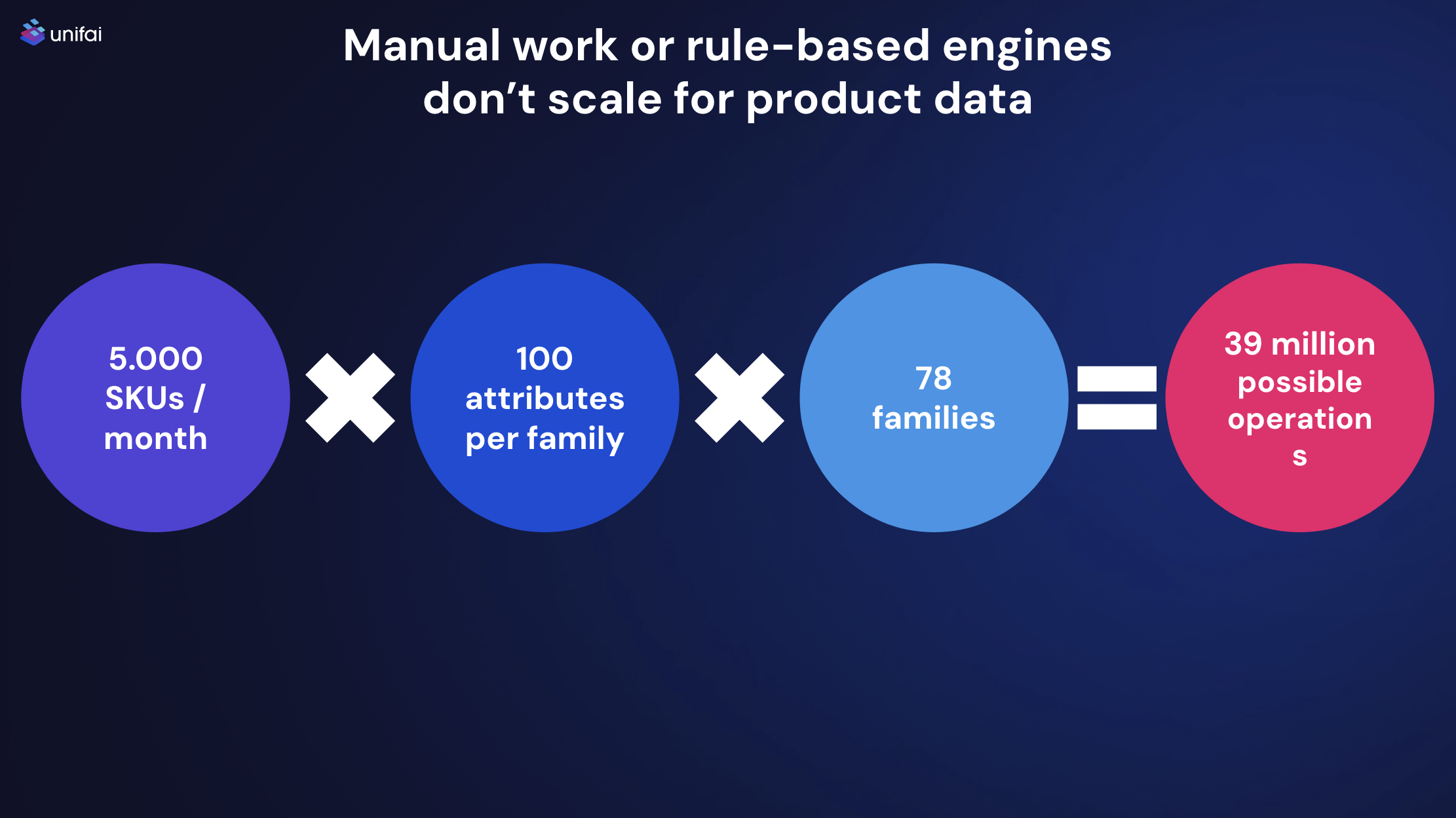Explore the transformative power of AI in creating seamless, consistent product experiences across all channels in this guest post by Unifai CEO and founder, Jesse Creange. Discover how AI is reshaping marketing excellence and team efficiency in today's retail landscape.

Table of Contents
Keywords
Even when buyers don’t make their purchases in brick-and-mortar stores, they expect in-person salespeople to be knowledgeable about online offerings. Print, despite the digital advancements, remains relevant, as do the vital roles of social media in all fields. Support channels play a central role, and there’s nothing more frustrating for a customer than dealing with a support agent who is not up to date on product information.
In summary, the era of selling products with just a barcode, a price, and an image is over; consumers are demanding more.
In this article, we will explore the inevitable importance of artificial intelligence (AI) in the world of creating compelling product experiences for consumers across all channels. We will demonstrate how AI is becoming an indispensable player in fulfilling the requirements for PX consistency, team efficiency, and overall marketing excellence in this complex and ever-changing landscape.
Businesses are increasingly turning to omnichannel strategies to reach their customers. However, behind this seemingly promising strategy lies numerous challenges. According to recent research, a striking statistic has emerged: 87% of customers will no longer make a purchase at a store where they encounter inaccurate information.
Let’s delve into the world of omnichannel challenges that many businesses seeking a successful customer experience face.
One of the first challenges of an omnichannel strategy is creating a consistent customer experience across all of these distinct channels. In today’s interconnected world, consumers have come to expect a seamless and unified experience when engaging with a company, irrespective of the channel through which they choose to interact. Whether it’s browsing a website, using a mobile app, engaging on social media platforms, or visiting a brick-and-mortar store, customers desire a harmonious journey. Here are five crucial facets that underscore the importance of customer consistency in an omnichannel environment:
One of the other core elements that demand special attention is the art of tailoring product descriptions to fit the unique characteristics and nuances of each channel.
As indicated by a recent study, “88% of respondents said that accurate, complete, and relevant product data is very important to create the best product experience.”
PXM Is The Key To Delivering Best-In-Class CX, Forrester Report
With the emergence of various channels, customers seek consistency across the entire experience offered by the seller. Consistency in the product experience isn’t limited to your main website or flagship store; customers expect it everywhere. It’s not about creating a one-size-fits-all product description for every channel; rather, it’s about crafting the perfect description tailored to the unique characteristics of each channel.
The practice of customizing descriptions for each channel underscores the understanding that every aspect of your omnichannel strategy possesses distinct nuances and requirements. Adapting product descriptions to suit these variations not only elevates the customer experience but also enhances the likelihood of resonating with your audience, fostering engagement, and ultimately driving sales.
When a company aspires to expand internationally while offering a consistent product experience, it faces a significant challenge. This challenge primarily manifests through the necessity to adapt its approach to each market while overcoming obstacles related to cultural differences, languages, and purchasing habits.
Language Barrier and Standardization of Product Information
One of the initial challenges is linguistic diversity. Each country has its own language, which means that product information must be accurately translated to reach the target audience. However, translation isn’t limited to mere word conversion; it must also consider cultural differences, units of measurement, wordplay, and local expressions to avoid misunderstandings and ensure the message is well understood.
Adapting the Product Experience to Each Market
Each international market has its unique characteristics concerning buying habits, preferences, and consumer behavior. For example, what works in a Western market may not be effective in Asia. It’s essential to adapt the product experience to each market to meet local needs and expectations.
The question remains, what tools and methods are required to succeed in addressing the omnichannel challenges while maintaining a respected customer experience?
As businesses embrace the omnichannel approach, their technology infrastructure has undergone a rapid and substantial transformation. A multitude of software solutions, each catering to specific facets of the omnichannel experience, has been integrated into the ecosystem. These include Product Information Management (PIM) systems, eCommerce platforms, Enterprise Resource Planning (ERP) software, search engines, support platforms, Product Lifecycle Management (PLM) systems, and the marketplaces they operate, to name just a few.
The consequence of this tech proliferation is that the number of Software as a Service (SaaS) solutions consuming data for brands and retailers has surged exponentially, sometimes multiplying by factors as high as 14.
The work involved in managing this extensive tech stack often becomes a daunting challenge. Traditional individual systems, designed to centralize product information, sometimes struggle to cope with the sheer complexity imposed by the multitude of operations required.
As an example, let’s consider just one aspect: Product attribute enrichment. Within the “collect” phase, which is just a fraction of the overall process, you might have to deal with 5,000 SKUs per month, each with 100 attributes per family across 78 different families. The result is a staggering 39 million possible operations, illustrating the immense intricacies involved in managing product data.

In this environment, the efficiency and effectiveness of your technology stack become paramount. Navigating this tech landscape requires a strategic approach that balances specialization with integration, streamlining workflows, and harnessing the power of AI and automation to manage the complexity efficiently.
In the pursuit of seamless product experiences, technology becomes not just a supporting actor but a central player in shaping the omnichannel narrative.
Artificial intelligence, when rigorously trained and closely monitored, can transform into well-trained experts specializing in managing and enhancing product data. These AI systems, whether based on advanced language models like LLM (Large Language Models) or other AI technologies, become instrumental in ensuring consistency across channels, software platforms, languages, and more.
Here’s how AI emerges as a game-changer in enhancing the product experience:
One of the ongoing challenges faced by companies is the collection, categorization, cleansing, and completion of basic product data. Without clean and accurate data as the foundation, it becomes nearly impossible to execute a robust product experience strategy. This process is often time-consuming and prone to errors when handled manually. AI applications, driven by deep learning algorithms, step in to automate and streamline this crucial phase. These AI systems can efficiently collect data from various sources, categorize products accurately, clean and normalize the data, and ensure that it meets the required standards. This not only saves time and reduces errors but also allows businesses to maintain a consistent and up-to-date product database. The role of clean data as the bedrock of a successful product experience strategy cannot be overstated, and AI plays a pivotal role in achieving this fundamental prerequisite.
Companies that use a modern PIM to centralize comprehensive, accurate, and properly categorized product data are well-positioned to leverage Gen-AI applications to help them generate compelling and channel-tailored product descriptions. These AI systems can generate compelling and well-formatted product descriptions based on the available data. They can also be fine-tuned to be SEO-driven, ensuring that product descriptions are not only appealing to customers but also optimized for search engines. This dual benefit enables businesses to not only capture the attention of their target audience but also enhance their online visibility and discoverability, further boosting the effectiveness of their product experience strategy.
Once companies have cleaned and enriched product data in their PIM, they can leverage AI-driven translation tools to efficiently translate and adapt their content for different markets and languages. This not only accelerates the localization process but also ensures that product information remains consistent and culturally relevant across regions.
In conclusion, AI emerges as a driving force in achieving PX maturity by automating and optimizing critical aspects of managing product data. From data collection and cleansing to content generation and translation, AI technologies empower businesses to deliver a consistent, engaging, and localized product experience across diverse channels and markets. Embracing AI in these areas not only enhances efficiency but also contributes to the overall success and growth of an omnichannel strategy.
This article was written as a guest blog for Akeneo by Unifai CEO, Jesse Creange.